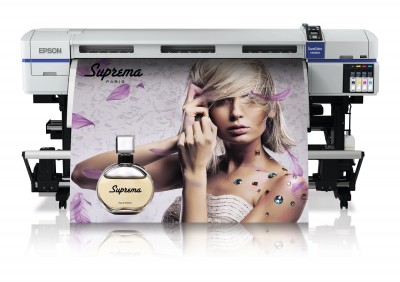The wide-format industry will also see innovations to make solvent-based printing ‘greener,’ i.e. less harmful for the environment and for people’s health. Manufacturers are improving formulations by using different types of solvents, avoiding harmful nickel compounds and delivering virtually odour-free printing, with no need for external dryers, special ventilation or air-purification systems.
These improvements are noteworthy because, while ultraviolet-curable (UV-curable) and ‘latex’ durable aqueous inks have certain advantages for some applications, solvent-based inks still offer the best overall combination of image quality and outdoor durability, along with low running costs. Commercial printing operations can thus integrate improved ‘green’ ink technology without sacrificing output quality.
Water-based white
White inks play a vital role in printing on transparent films, such as those used for window graphics, as a layer of white has to be laid down first as a background before other colours are added. Water-based white inks can be conveniently and inexpensively used for printing proofs on these films. Proofs might be output from the same machine used for production printing or by using a dedicated proof printer.

Today’s wide-format printers offer greater versatility for producing different signage applications, including posters, floor graphics, murals, banners and backlit displays.
Steps to improve sustainability
In the past few years, the wide-format printed graphics market has seen a lot of this type of improvement in terms of sustainability. Many sign shops have realized an environmentally responsible approach—with expanded product recycling programs, ‘green substrates’ and more energy-efficient machines—is simply a better way of doing business.
These transitions and sustainability initiatives, however, have sometimes been very challenging. With digital inkjet graphic production, for example, much of the output has tended to be printed or mounted on substrates that are costly to recycle, if they can be recycled at all.
Many sign shops want to support practices and technologies that have less impact on the environment, but are hesitant to pay higher costs to ‘go green.’ Fortunately, some improved inkjet printing systems—e.g. with lower power consumption—have been developed without having to charge signmakers a premium.
Overall, the wide-format printing industry still has a long way to go to achieve ideal sustainability, but each step forward is an essential investment in the future. ‘Business as usual’ will not help the industry reach its goals in terms of minimizing consumption of energy and resources, recycling materials, reducing the use of harmful substances and eliminating waste. The key is to implement environmental management systems (EMSs), with a continual focus on improving eco-performance at each stage of graphic production, transportation and use.
Reed Hecht is a professional imaging product manager for Epson, which manufactures wide-format printers. For more information, visit www.epson.ca.





